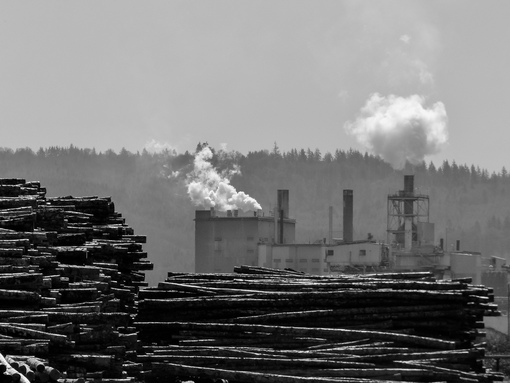
Photograph by Jeffrey St. Clair
America needs forest–and housing–policy to include end-use of the trees we fell.
As many Americans know all too well, concerns about forest conservation and affordable housing have drawn increasing attention across the US. These topics are of special interest in regions where logging is primarily devoted to provided lumber for human housing.
What may be less known is that the pairing of forest and housing policy has had a long and colorful history spanning the past 70 years.
In his 1947 book, Breaking New Ground, Gifford Pinchot, an early head of the U.S. Forest Service, wrote that, “The rightful use and purpose of our natural resources is to make all the people strong and well, able and wise, well-clothed, well-housed…with equal opportunity for all and special privilege for none.”
Back then, if only briefly, America’s political leadership was responsive to ordinary needs and dreams of being “well-housed.” In 1949, America passed its Housing Act, which stated that it is the policy of the United States to provide “…a decent home and suitable environment for every American family.”
With this, Congress stated a clear end-use of forest products when logging delivers wood to the market.
That was the end-use then. It’s not happening now, but it remains a core rationale promoted by the logging industry. After all, there’s plausibly no better way to endear logging to the public than to connect the dots from falling forest to rising homes for families.
This basic rationale casts homes as needs, with forest conservation and especially wilderness designation thus an unnecessary luxury. Alas, while preaching a pious public line of family values, politicians of both major parties have provided the means by which forest falls so that every wealthy family could afford luxurious housing.
In the US, the Mortgage Interest Deduction has played an important role in this switch. Tax givebacks under the Mortgage Interest Deduction let extravagant homebuyers deduct interests costs of borrowing for bigger and more expensive homes. This tax deduction is even given for second homes/vacation homes, even in habitat important to endangered species, even in forests prone to fire as the western US gets hotter and drier, and in many cases driving demand for toppling of shrinking old growth forests to get logs big enough to impress.
In 1995, for example, Winton Pitcoff summed up the state of housing in America for March/April issue of Dollars & Sense. Pitcoff reported that, “Thirty years ago the nation boasted a surplus of housing affordable to low income people. Today there is a shortage of more than four million units.”
The loss was no secret. It was actually a matter of public record. By 1995, the U.S. Census Bureau’s American Housing Survey would report a “43 percent decline over the last two decades in the number of low-rent units in the private housing market.”
This decline continued under Democrats as well as Republicans. Pitcoff explained that the supply of affordable housing declined by 900,000 units” in just the two years from 1996-1998 alone.
Meanwhile, according to Dollars & Sense magazine, mortgage interest giveaways amounted to $82 billion in 1999 alone, much of it tapping forests for the sake of the prosperous, while the poor were priced out. Cushing Dolbeare, founder of the National Low Income Housing Coalition, was cited in a Dollars & Sense interview saying, “ If we were willing to spend as much on low and middle income housing as we do on the Mortgage Interest Deduction, we’d have more than enough to solve the housing crisis.”
During recent construction booms, the Wall Street Journal would report in early 2000, homes get bigger. Like Americans’ waistlines, the Journal observed, the new American home was getting much bigger, and more extravagant. While affordable housing was uncomfortably rare for the Americans who most needed it, the fortunate were demanding homes with “more bedrooms, more bathrooms, and more flourishes than ever before.”
Architects and even the builders of luxury homes were noticing the trend. An architect told the Journal that the trend was “appalling.” He said that the bigger-is-better trend was about showing off to neighbors. In his opinion, people buying luxury homes were saying, “I can be a 1920s tycoon like anybody else.”
One American builder of luxury homes interviewed by the Wall Street Journal was quoted saying, “Does anybody need all this? No.”
Is this what Americans expect as the end use of the forests?
In 1981, Mihaly Csikszentmihalyi and Eugene Rochberg-Halton gave this broad trend a close look in their book, The Meaning of Things. The two behavioral scientists say that “a habit of consumption can become an end in itself.” Locked into “deadly inertia,” they say, the drive to possess more and more becomes an “addiction” that has been described as “terminal materialism.”
As Csikszentmihalyi and Rochberg-Halton see it, when people enter this state of mind, “… the earth, the forests, the dwellings, and the psychic energy of people can all be mined for the specific utility of the transaction, regardless of what wider consequences or outcomes these acts might cause.” So understood, the simultaneously perverse character of American forest- and housing-policy alike has come to an ugly state of affairs ecologically, economically, politically, and socially.